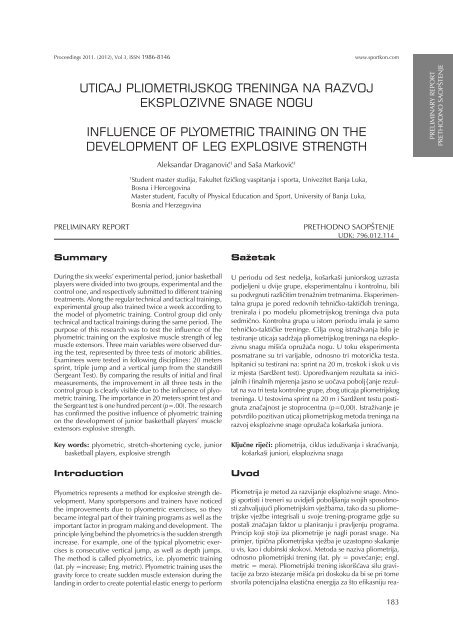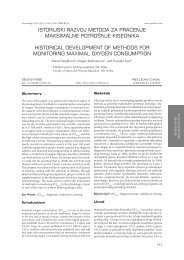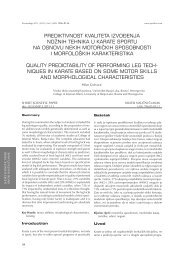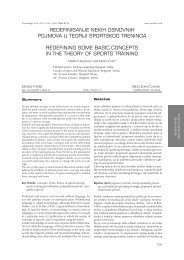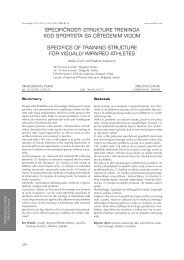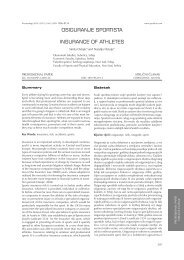uticaj pliometrijskog treninga na razvoj eksplozivne snage nogu ...
uticaj pliometrijskog treninga na razvoj eksplozivne snage nogu ...
uticaj pliometrijskog treninga na razvoj eksplozivne snage nogu ...
Create successful ePaper yourself
Turn your PDF publications into a flip-book with our unique Google optimized e-Paper software.
Proceedings 2011. (2012), Vol 3, ISSN 1986-8146<br />
www.sportkon.com<br />
UTICAJ PLIOMETRIJSKOG TRENINGA NA RAZVOJ<br />
EKSPLOZIVNE SNAGE NOGU<br />
INFLUENCE OF PLYOMETRIC TRAINING ON THE<br />
DEVELOPMENT OF LEG EXPLOSIVE STRENGTH<br />
PRELIMINARY REPORT<br />
PRETHODNO SAOP[TENJE<br />
Aleksandar Draganović 1 and Sa{a Markovi} 1<br />
1<br />
Student master studija, Fakultet fizičkog vaspitanja i sporta, Univezitet Banja Luka,<br />
Bos<strong>na</strong> i Hercegovi<strong>na</strong><br />
Master student, Faculty of Physical Education and Sport, University of Banja Luka,<br />
Bosnia and Herzegovi<strong>na</strong><br />
PRELIMINARY REPORT<br />
PRETHODNO SAOP[TENJE<br />
UDK: 796.012.114<br />
Summary<br />
During the six weeks’ experimental period, junior basketball<br />
players were divided into two groups, experimental and the<br />
control one, and respectively submitted to different training<br />
treatments. Along the regular technical and tactical trainings,<br />
experimental group also trained twice a week according to<br />
the model of plyometric training. Control group did only<br />
technical and tactical trainings during the same period. The<br />
purpose of this research was to test the influence of the<br />
plyometric training on the explosive muscle strength of leg<br />
muscle extensors. Three main variables were observed during<br />
the test, represented by three tests of motoric abilities.<br />
Examinees were tested in following disciplines: 20 meters<br />
sprint, triple jump and a vertical jump from the standstill<br />
(Sergeant Test). By comparing the results of initial and fi<strong>na</strong>l<br />
measurements, the improvement in all three tests in the<br />
control group is clearly visible due to the influence of plyometric<br />
training. The importance in 20 meters sprint test and<br />
the Sergeant test is one hundred percent (p=.00). The research<br />
has confirmed the positive influence of plyometric training<br />
on the development of junior basketball players’ muscle<br />
extensors explosive strength.<br />
Key words: plyometric, stretch-shortening cycle, junior<br />
basketball players, explosive strength<br />
Introduction<br />
Plyometrics represents a method for explosive strength development.<br />
Many sportspersons and trainers have noticed<br />
the improvements due to plyometric exercises, so they<br />
became integral part of their training programs as well as the<br />
important factor in program making and development. The<br />
principle lying behind the plyometrics is the sudden strength<br />
increase. For example, one of the typical plyometric exercises<br />
is consecutive vertical jump, as well as depth jumps.<br />
The method is called plyometrics, i.e. plyometric training<br />
(lat. ply =increase; Eng. metric). Plyometric training uses the<br />
gravity force to create sudden muscle extension during the<br />
landing in order to create potential elastic energy to perform<br />
Sažetak<br />
U periodu od {est nedelja, ko{arka{i juniorskog uzrasta<br />
podjeljeni u dvije grupe, eksperimentalnu i kontrolnu, bili<br />
su podvrgnuti različitim tre<strong>na</strong>žnim tretmanima. Eksperimental<strong>na</strong><br />
grupa je pored redovnih tehničko-taktičkih <strong>treninga</strong>,<br />
trenirala i po modelu <strong>pliometrijskog</strong> <strong>treninga</strong> dva puta<br />
sedmično. Kontrol<strong>na</strong> grupa u istom periodu imala je samo<br />
tehničko-taktičke treninge. Cilja ovog istraživanja bilo je<br />
testiranje <strong>uticaj</strong>a sadržaja <strong>pliometrijskog</strong> <strong>treninga</strong> <strong>na</strong> eksplozivnu<br />
s<strong>na</strong>gu mi{ića opružača <strong>nogu</strong>. U toku eksperimenta<br />
posmatrane su tri varijable, odnosno tri motorička testa.<br />
Ispitanici su testirani <strong>na</strong>: sprint <strong>na</strong> 20 m, troskok i skok u vis<br />
iz mjesta (Sardžent test). Upoređivanjem rezultata sa inicijalnih<br />
i fi<strong>na</strong>lnih mjerenja jasno se uočava poboljšanje rezultat<br />
<strong>na</strong> sva tri testa kontrolne grupe, zbog <strong>uticaj</strong>a <strong>pliometrijskog</strong><br />
<strong>treninga</strong>. U testovima sprint <strong>na</strong> 20 m i Sardžent testu postignuta<br />
z<strong>na</strong>čajnost je stoprocent<strong>na</strong> (p=0,00). Istraživanje je<br />
potvrdilo pozitivan <strong>uticaj</strong> <strong>pliometrijskog</strong> metoda <strong>treninga</strong> <strong>na</strong><br />
<strong>razvoj</strong> <strong>eksplozivne</strong> s<strong>na</strong>ge opružača ko{arka{a juniora.<br />
Ključne riječi: pliometrija, ciklus izduživanja i skraćivanja,<br />
ko{arka{i juniori, eksploziv<strong>na</strong> s<strong>na</strong>ga<br />
Uvod<br />
Pliometrija je metod za razvijanje <strong>eksplozivne</strong> s<strong>na</strong>ge. Mnogi<br />
sportisti i treneri su uvidjeli pobolj{anja svojih sposobnosti<br />
zahvaljujući pliometrijskim vježbama, tako da su pliometrijske<br />
vježbe integrisali u svoje trening-programe gdje su<br />
postali z<strong>na</strong>čajan faktor u planiranju i pravljenju programa.<br />
Princip koji stoji iza pliometrije je <strong>na</strong>gli porast s<strong>na</strong>ge. Na<br />
primjer, tipič<strong>na</strong> pliometrijska vježba je uzastopno skakanje<br />
u vis, kao i dubinski skokovi. Metoda se <strong>na</strong>ziva pliometrija,<br />
odnosno pliometrijski trening (lat. ply = povećanje; engl.<br />
metric = mera). Pliometrijski trening iskori{ćava silu gravitacije<br />
za brzo istezanje mi{ića pri doskoku da bi se pri tome<br />
stvorila potencijal<strong>na</strong> elastič<strong>na</strong> energija za {to efikasniju rea-<br />
183
Draganovi}, A. & Markovi', S.: INFLUENCE OF PLYOMETRIC TRAINING ... Proceedings 2011, 183–188<br />
PRELIMINARY REPORT<br />
PRETHODNO SAOP[TENJE<br />
the landing concentric phase as efficiently as possible. The<br />
basic purpose of plyometric training is the development of<br />
as greater as possible reactive force.<br />
Plyometric exercises are important for the training process<br />
because they use all the aptitudes of the muscle stretchshortening<br />
cycle (SSC). Elastic muscle components are capable<br />
to storage energy during the stretch phase (landing),<br />
so that energy can be used during the muscle contraction<br />
phase (i.e. landing shortening). The SSC was discovered<br />
during the realization that body parts are constantly submitted<br />
to stretch force. Running, walking and jumping are<br />
typical examples of human movement, which show how<br />
exter<strong>na</strong>l forces (gravity force) stretch muscles. During the<br />
stretch phase, the muscle operates in an eccentric way, and<br />
afterwards in a concentric one. In the eccentric phase, the<br />
muscles have to be active during the stretching. The combi<strong>na</strong>tion<br />
of the eccentric and concentric muscle action makes<br />
<strong>na</strong>tural feature of muscle function called stretch-shortening<br />
cycle (SSC) (Norman & Komi 1979; Komi 1984, 2000). This<br />
type of muscle function also includes the phase of pre-activation.<br />
SSC has clearly expressed function of performance<br />
increase during the fi<strong>na</strong>l phase (concentric contractions) in<br />
comparison to isolated concentric contractions. When the<br />
period between stretching and shortening is different, there<br />
is also a difference between the created forces of SSC of<br />
knee extension. When there is no pause between the contractions,<br />
the greater force is clearly visible in the concentric<br />
phase.<br />
From all above mentioned, it can be concluded that the<br />
purpose of this work is to determine to what extent plyometric<br />
training influences the development of junior basketball<br />
players’ muscle extensors explosive strength.<br />
lizaciju koncentrične faze odskoka. Osnov<strong>na</strong> svrha <strong>pliometrijskog</strong><br />
<strong>treninga</strong> jeste <strong>razvoj</strong> {to veće reaktivne sile.<br />
Pliometrijske vježbe su z<strong>na</strong>čajne za tre<strong>na</strong>žni proces zbog<br />
toga jer koriste pogodnosti ciklusa izduživanja i skraćivanja<br />
(Stretch-Shortening Cycle – SSC) u mi{ićima. Elastič<strong>na</strong> komponenta<br />
mi{ića je u mogućnosti da uskladi{ti energiju za<br />
vrijeme istezanja (doskoka), pa se ta energija može koristiti<br />
za vrijeme kontrakcije mi{ića (skraćivanja tj. odraza). Do SSC<br />
se do{lo iz zapažanja da su dijelovi tijela konstantno izloženi<br />
<strong>uticaj</strong>u sila rastezanja. Trčanje, hodanje i skakanje su tipični<br />
primjeri u ljudskom kretanju, kako spolja{nja sila<br />
(gravitacije) izdužuje mi{iće. U fazi izduživanja mi{ić djeluje<br />
ekscentrično, a posle nje koncentrično . U ekscentričnoj<br />
fazi mi{ići moraju biti aktivni tokom izduživanja. Kombi<strong>na</strong>ciaj<br />
ekscentrične i koncentrične mi{ićne akcije čini prirodni<br />
oblik mi{ićne funkcije <strong>na</strong>zvan ciklus izduživanja i skraćivanja<br />
(Stretch-Shortning Cycle, SSC) (Norman i Komi 1979; Komi<br />
1984, 2000). Ovaj tip mi{ićne funkcije takođe uključuje i<br />
fazu preaktivacije. SSC ima jasno izraženu funkciju povećanja<br />
učinka za vrijeme fi<strong>na</strong>lne faze (koncentrične kontrakcije)<br />
u poređenju sa izolovanom koncentričnom kontrakcijom.<br />
Kada je period između izduživanja i skraćivanja različit<br />
postoji razlika u stvorenoj sili pri SSC pri ekstenziji kolje<strong>na</strong><br />
kod ljudi. Kada nema pauze između kontrakcija veća sila je<br />
jasno vidljiva u koncentričnoj fazi.<br />
Iz prethodno <strong>na</strong>vedenog proizilazi i cilj ovog rada koji je bio<br />
da se utvrdi u kolikoj mjeri sadržaji pliometrisjkog <strong>treninga</strong><br />
utiču <strong>na</strong> <strong>razvoj</strong> <strong>eksplozivne</strong> s<strong>na</strong>ge opružača <strong>nogu</strong> kod ko{arka{a<br />
juniora.<br />
Methods<br />
Sample of respondents<br />
Test groups consist of 23 junior basketball players, members<br />
of BC “Radnik” Bijelji<strong>na</strong> and BC “Plus” Bijelji<strong>na</strong>. All the<br />
examinees are of normal health status, and are divided into<br />
two groups: experimental and control one.<br />
Sample of variables<br />
Chosen variables were adjusted to the age of examinees and<br />
the subject of this research, and are reflected in motoric tests<br />
which estimate explosive leg muscle strength.<br />
• 20 meters sprint (T20M)<br />
• Triple jump (TRS)<br />
• Vertical jump (SAR)<br />
Testing was conducted in a school hall on the parquet surface.<br />
Every examinee wore sports uniform. There were two examiners<br />
needed. Used equipment consisted of: meter,<br />
stopwatch, mat and spring board. Every examinee performed<br />
the test three times, and only the best results were registered.<br />
Reserach procedures<br />
During the six weeks’ period, experimental group trained<br />
on the basis of plyometric training two times a week, while<br />
control group had regular technical and tactical trainings.<br />
The program of plyometric training used in this research<br />
consisted of different jumps from the standstill and movement,<br />
hops, skips, jumps on the boxes etc. During the first<br />
week, the examinees performed exercises in two series of<br />
Metode<br />
Uzorak ispitanika<br />
Uzorak ispitanika čine dvadeset i tri ko{arka{a juniorskog<br />
uzrasta, članovi KK »Radnik« Bijelji<strong>na</strong> i KK »Plus« Bijelji<strong>na</strong>.<br />
Svi ispitanici su normalnog zdravstvenog statusa, podjeljeni<br />
u dvije grupe: eksperimentalnu i kontrolnu.<br />
Uzorak varijabli<br />
Izabrane varijable su prilagođene uzrastu ispitanika i predmetu<br />
ovog istraživanja, a to su motorički testovi koji procjenjuju<br />
eksplozivnu s<strong>na</strong>gu mi{ića <strong>nogu</strong>.<br />
• Sprint <strong>na</strong> 20 metara (T20M)<br />
• Troskok (TRS)<br />
• Skok u vis iz mjesta (SAR)<br />
Testiranje je sprovedeno u {kolskoj sali <strong>na</strong> parketnoj podlozi.<br />
Svaki ispitanik je bio u sportskoj opremi. Za testiranje su<br />
bila potreba dva mjerioca. Kori{teni rekviziti su bili: metar,<br />
{toperica, strunjače i odskoč<strong>na</strong> daska. Svi testovi su demonstrirani<br />
i obja{njeni prije izvođenja. Svaki ispitanik izvodio<br />
je test tri puta, a registrovan je <strong>na</strong>jboji postignuti rezultat.<br />
Procedure istraživanja<br />
U periodu od {est sedmica eksperimental<strong>na</strong> grupa trenirala<br />
je po modelu <strong>pliometrijskog</strong> <strong>treninga</strong> dva puta sedmično,<br />
dok je kontrol<strong>na</strong> grupa imala redovne tehničko-taktičke<br />
treninge. Program <strong>pliometrijskog</strong> <strong>treninga</strong> kori{tenog u ovom<br />
istraživanju sastojao se od različitih skokova u mjestu i u<br />
kretanju, poskoka, preskoka, skokova <strong>na</strong> sanduk itd. Tokom<br />
prve sedmice programa ispitanici su vježbe izvodili u dvije<br />
184
Draganovi}, A. i Markovi}, S.: UTICAJ PLIOMETRIJSKOG TRENINGA... Zbornik radova 2011, 183–188<br />
8 to 10 repetitions within each series. At the beginning of<br />
the program, the easier exercises domi<strong>na</strong>ted, while they<br />
became more complicated and there were more repetitions<br />
as examinees improved, reaching 10 to 15 repetitions. In<br />
the first week, easier exercises like skips or hops on the<br />
basketball board domi<strong>na</strong>ted, with around 100 contacts with<br />
the ground. In the sixth week, more complex exercises of a<br />
greater intensity (jump on the bench, wave jumps, quad<br />
jump) prevailed, while the number of contacts with the<br />
ground increased to 150. In order to familiarize examinees,<br />
all exercises were explained and demonstrated before.<br />
Statistical a<strong>na</strong>lysis<br />
All the data attained in this research are going to be processed<br />
using descriptive and comparative statistical a<strong>na</strong>lysis. Using<br />
descriptive a<strong>na</strong>lysis of the complete specimen, arithmetic<br />
mean and standard deviation will be determined. Within<br />
the range of comparative statistics, t-test for independent<br />
specimens for comparison of average values of initial and<br />
fi<strong>na</strong>l measurements between each groups was applied. p
Draganovi}, A. & Markovi', S.: INFLUENCE OF PLYOMETRIC TRAINING ... Proceedings 2011, 183–188<br />
Results of fi<strong>na</strong>l measurements<br />
Rezultati fi<strong>na</strong>lnih mjerenja<br />
PRELIMINARY REPORT<br />
PRETHODNO SAOP[TENJE<br />
Tables 3 and 4 show results obtained during the fi<strong>na</strong>l measurement<br />
for experimental and control group. Both specimens<br />
include descriptive and comparative statistic. It is noticeable<br />
that the results of the fi<strong>na</strong>l measurement show important<br />
statistical improvement in the results of experimental group<br />
in all three tests, while the control group remained at the<br />
similar level where it was at the initial measurement.<br />
Tabela 3: Deskriptiv<strong>na</strong> a<strong>na</strong>liza fi<strong>na</strong>lnog mjerenja kontrolne i eksperimentalne grupe<br />
Table 3: Descriptive a<strong>na</strong>lysis of the fi<strong>na</strong>l measurements of control and experimental group<br />
U Tabelama 3 i 4 prikazani su rezultati dobijeni <strong>na</strong> inicijalnom<br />
mjerenju za eksperimentalnu i kontrolnu grupu. Za oba<br />
uzorka obrađe<strong>na</strong> je deskriptiv<strong>na</strong> i komparativ<strong>na</strong> statistika.<br />
Uočavamo da je <strong>na</strong> fi<strong>na</strong>lnom mjerenju ekspreimental<strong>na</strong><br />
grupa statistički z<strong>na</strong>čajno pobolj{ala svoje rezultate u sva tri<br />
testa, dok je kontrol<strong>na</strong> ostala <strong>na</strong> približnom nivou kao <strong>na</strong><br />
inicijalnom mjerenju<br />
Varibale<br />
N M SD CV<br />
Con. Exp. Con. Exp. Con. Exp. Con. Exp.<br />
T20 (sec) 10 13 3.76 3.09 .17 .23 .040 .07<br />
TRS (cm) 10 13 631.00 679.90 41.53 42.09 .060 .06<br />
SAR (cm) 10 13 45.60 52.54 6.70 4.31 .015 .08<br />
Legend/Legenda: N – Number of respondents (Broj ispitanika); M – Sample mean (Aritmeti~ka<br />
sredi<strong>na</strong>); SD - Standard deviation (Standard<strong>na</strong> devijacija); CV - Coefficient of variation<br />
(Koeficijent varijacije); Con. - Control group (Kontrol<strong>na</strong> grupa); Exp. - Experimental group<br />
(Eksperimental<strong>na</strong> grupa); T20 - 20 meters sprint (Sprint <strong>na</strong> 20 metara); TRS - Triple jump<br />
(Troskok); SAR - Vertical jump (Skok u vis iz mjesta).<br />
Tabela 4: Komparativ<strong>na</strong> a<strong>na</strong>liza fi<strong>na</strong>lnog mjerenja kontrolne i eksperimentalne grupe<br />
Table 4: Comparative a<strong>na</strong>lysis of fi<strong>na</strong>l measurement in control and experimental group<br />
Variable Con. Exp. t p<br />
T20 (sec) 3.76 3.09 7.38 .000<br />
TRS (cm) 631.00 679.90 -2.78 .000<br />
SAR (cm) 45.60 52.54 5.38 .000<br />
Legend/Legenda: t - Student's distribution - Studenova distribucija; p - Probability (Vjerovatno}a);<br />
Con. - Control group (Kontrol<strong>na</strong> grupa); Exp. - Experimental group (Eksperimental<strong>na</strong> grupa);<br />
T20 - 20 meters sprint (Sprint <strong>na</strong> 20 metara); TRS - Triple jump (Troskok); SAR - Vertical<br />
jump (Skok u vis iz mjesta).<br />
Slika 1: Z<strong>na</strong>čajnost razlika aritmetičkih sredi<strong>na</strong> testa sprint<br />
<strong>na</strong> 20 metara ispitanika eksperimentalne i kontrolne<br />
grupe u inicijalnom i fi<strong>na</strong>lnom mjerenju<br />
Figure 1: Importance of differences in arithmetic means of<br />
20m sprint test on the examinees in the experimental<br />
and control group during the initial and the fi<strong>na</strong>l measurement<br />
4.5<br />
Slika 2: Z<strong>na</strong>čajnost razlika aritmetičkih sredi<strong>na</strong> testa Troskok<br />
ispitanika eksperimentalne i kontrolne grupe u<br />
inicijalnom i fi<strong>na</strong>lnom mjerenju<br />
Figure 2: Importance of differences in arithmetic means in<br />
triple jump test on the examinees in the experimental<br />
and control group during the initial and fi<strong>na</strong>l measurement<br />
690.00<br />
4<br />
680.00<br />
3.5<br />
670.00<br />
3<br />
660.00<br />
2.5<br />
2<br />
1.5<br />
Initial<br />
Fi<strong>na</strong>l<br />
650.00<br />
640.00<br />
630.00<br />
Initial<br />
Fi<strong>na</strong>l<br />
1<br />
620.00<br />
0.5<br />
610.00<br />
0<br />
Control<br />
Experimental<br />
600.00<br />
Control<br />
Experimental<br />
Discussion<br />
The research being conducted in a form of an experiment,<br />
the results of the initial measurements showed that the groups<br />
were homogeneous and that methodological requirements<br />
for valid research were met. Due to that fact, every statisti-<br />
Diskusija<br />
Po{to je istraživanje realizovano u formi eksperimenta sa<br />
paralelnim grupama, rezultati inicijalnih mjerenja su pokazali<br />
da su grupe homogene i da je zadovoljen metodolo{ki<br />
186
Draganovi}, A. i Markovi}, S.: UTICAJ PLIOMETRIJSKOG TRENINGA... Zbornik radova 2011, 183–188<br />
cally important difference that might appear in the results<br />
of groups during the initial measurement was attributed to<br />
the application of plyometric training process on the experimental<br />
group.<br />
zahtjev za validno istraživanje. Stoga svaka statistički z<strong>na</strong>čaj<strong>na</strong><br />
razlika koja bi eventualno <strong>na</strong>stala u rezultatima između<br />
grupa <strong>na</strong> fi<strong>na</strong>lnom mjerenju, pripisuje se primjeni <strong>pliometrijskog</strong><br />
tre<strong>na</strong>žnog procesa <strong>na</strong> eksperimentalnu grupu.<br />
Slika 31: Z<strong>na</strong>čajnost razlika aritmetičkih sredi<strong>na</strong> Sardžent testa ispitanika eksperimentalne i kontrolne grupe u inicijalnom<br />
i fi<strong>na</strong>lnom mjerenju<br />
Figure 3: Importance of the differences in arithmetic means on the Sergeant test on the examinees of the experimental<br />
and control group during the initial and fi<strong>na</strong>l measurement<br />
54.00<br />
52.00<br />
PRELIMINARY REPORT<br />
PRETHODNO SAOP[TENJE<br />
50.00<br />
48.00<br />
46.00<br />
Initial<br />
Fi<strong>na</strong>l<br />
44.00<br />
42.00<br />
By comparing the results obtained during the initial measurement,<br />
it is noticeable that groups were not statistically different<br />
in average values in all three tests. Values in M Sergeant<br />
Test during the initial measurement were almost identical.<br />
Concerning other two tests, it can be noticed that the variability<br />
of results in both tested groups are nearly the same.<br />
Nevertheless, the fi<strong>na</strong>l measurement shows completely<br />
different results. Application of experimental treatment<br />
changed average values in all three tests within the experimental<br />
group, while the results of the control group remained<br />
on the same level as on the initial measurement. A hundred<br />
percent importance (p=.000) was achieved in all three tests.<br />
Especially important improvement was noticed in the vertical<br />
jump from a standstill (Sergeant Test) because basketball<br />
players are familiar with that activity and they use it very<br />
often during trainings and matches, so there was a fear of<br />
poorer improvement during the training process.<br />
As opposed to a 20m sprint and triple jump, where there<br />
are multiple contacts with the ground and where the ability<br />
of muscles to stretch and shorten more quickly is emphasized,<br />
the vertical jump from a standstill has no ground contact and<br />
SSC cycle’s influence is smaller. This fact makes the improvement<br />
of results in this test even more important.<br />
Based upon the differences in results during two measurements,<br />
it can be concluded that plyometric training made<br />
positive impact on the development of explosive strength in<br />
the experimental group, while at the same time technical<br />
and tactical trainings of the control group were not good<br />
enough to develop the same ability.<br />
Conclusion<br />
Control<br />
During a six weeks’ period, the effects of plyometric training<br />
on the explosive strength of leg muscle extensors were observed.<br />
Twenty-three examinees were divided into the<br />
control and the experimental groups, and were submitted<br />
to six weeks’ treatment. During that time, three variables<br />
were taken into account: a 20m sprint, a triple jump, and a<br />
Experimental<br />
Upoređivanjem rezultata dobijenih <strong>na</strong> inicijalnom mjerenju<br />
vidimo da se grupe nisu statistički razlikovale u prosječnim<br />
vrijednostima sva tri testa. Vrijednosti M Sardžent testa <strong>na</strong><br />
inicijalnom mjerenju je bila skoro identič<strong>na</strong>. Kad su u pitanju<br />
druga dva testa primjećujemo da je i tu varijabilitet rezultata<br />
u obje testirane grupe približno isti. Međutim, <strong>na</strong> fi<strong>na</strong>lnom<br />
mjerenju imamo potpuno drugačije vrijednosti. Primjenom<br />
eksperimentalnog tretma<strong>na</strong> promjenile su se prosječne<br />
vrijednosti sva tri testa u okviru eksperimentalne grupe, dok<br />
su se rezultati kontrolne grupe zadržale <strong>na</strong> nivou sa inicijalnog<br />
mjerenja. Stoprocent<strong>na</strong> z<strong>na</strong>čajnost (p=0,000) je postignuta<br />
<strong>na</strong> sva tri testa. Posebno z<strong>na</strong>čajan je <strong>na</strong>predak u<br />
skoku u vis iz mjesta (Sardžent test) jer je to aktivnost koja<br />
je ko{arka{ ima poz<strong>na</strong>ta i često je koriste <strong>na</strong> treningu i utakmicama,<br />
tako da je postojala bojazan o slabijem <strong>na</strong>predovanju<br />
kroz tre<strong>na</strong>žni proces.<br />
Za razliku od sprinta <strong>na</strong> 20 metara i troskoka gdje postoji<br />
vi{e uzastopnih kontakata sa podlogm i gdje do izražaja<br />
dolazi sposobnost mi{ića da se brzo izduže i kontrahuju, u<br />
skoku u vis iz mjesta nema prethodnog kontakta sa podlogom<br />
i <strong>uticaj</strong> ciklusa izduživanja i skraćivanja (SSC ciklus) je manji.<br />
U tome je i veći z<strong>na</strong>čaj pobolj{anje rezultata <strong>na</strong> ovom testu.<br />
Na osnovu dobijenih razlika u rezultatima <strong>na</strong> dva mjerenja,<br />
dolazi se do zaključka da je pliometrijski trening pozitivno<br />
uticao <strong>na</strong> <strong>razvoj</strong> eksplozivnosti kod eksperimentalne grupe,<br />
dok tehničko-taktički treninzi kontrolne grupe nisu bili dovoljni<br />
za ravoj iste sposobnosti.<br />
Zaključak<br />
U periodu od {est nedelja ispitivani su efekti <strong>pliometrijskog</strong><br />
<strong>treninga</strong> <strong>na</strong> <strong>razvoj</strong> eksploivne s<strong>na</strong>ge opružača <strong>nogu</strong>. Dvadeset<br />
i tri ispitanika podjeljenih u kontrolnu i eksperimentalnu<br />
grupu bili su podvrgnuti {estonedeljnom tretmanu. U toku<br />
rada posmatrane su tri varijable:sprint <strong>na</strong> 20 metara, troskok<br />
i skok u vis iz mjesta. Upoređivanjem rezulatata sa inicijalnog<br />
187
Draganovi}, A. & Markovi', S.: INFLUENCE OF PLYOMETRIC TRAINING ... Proceedings 2011, 183–188<br />
PRELIMINARY REPORT<br />
PRETHODNO SAOP[TENJE<br />
vertical jump from a standstill. By comparing the results from<br />
initial and fi<strong>na</strong>l measurements, following results were obtained<br />
which led to the following conclusions:<br />
• Plyometric training model applied in the experimental<br />
group showed its efficiency related to all three tests in<br />
motor development. After six weeks of training there<br />
was the improvement of 26 cm in triple jump test, 6<br />
cm in Sergeant test and .58 sec better average time in<br />
20 m sprint, when compared to the results from the<br />
initial measurement. These results bring us to conclusion<br />
that plyometric training model efficiently influences<br />
the improvement in explosive strength of leg<br />
muscle extensors.<br />
• In most of the tests, the control group did not show<br />
any improvement of results. However, there was a slight<br />
improvement in 20 m sprint test (.06 sec) that can be<br />
ascribed to the greater motivation in the fi<strong>na</strong>l measurement.<br />
At the end of this experiment, it can be concluded that the<br />
application of plyometric training to the improvement of<br />
explosive strength of leg muscle extensors made positive<br />
impact to the development of this motor feature. The results<br />
of this experiment show that Stretch-Shortening Cycle – SSC,<br />
which is a base of plyometric exercises, has positively influenced<br />
the improvement of results in tests that measure explosive<br />
strength. Six weeks of plyometric training process<br />
showed to be enough to achieve greater improvement in<br />
leg muscle extensors explosive strength improvement in<br />
junior basketball players. In order to achieve even better<br />
results, the training process should last even longer and<br />
should include proper dosing in order to avoid eventual<br />
injuries that come with such a type of training.<br />
i fi<strong>na</strong>lnog mjerenja dobijeni su rezultati <strong>na</strong> osnovu kojih su<br />
doneseni sledeći zaključci:<br />
• Pliometrijski model <strong>treninga</strong> primjenjen u eksperimentalnoj<br />
grupi pokazao se efikasnim u pogledu pobolj{anja<br />
sva tri motorička testa. Posle {est nedelja <strong>treninga</strong>, u<br />
odnosu <strong>na</strong> inicijal<strong>na</strong> mjrenja zabilježen je <strong>na</strong>predak od<br />
26 cm u testu troskok, 6 cm u Sardžent testu i 0,58 sec<br />
brže prosječno vrijeme <strong>na</strong> testu sprint <strong>na</strong> 20 metara.<br />
Ovi rezultati dovode do zaključka da pliometrijski<br />
model <strong>treninga</strong> efikasno utiče <strong>na</strong> pobolj{anje <strong>eksplozivne</strong><br />
s<strong>na</strong>ge opružača <strong>nogu</strong>.<br />
• U kontrolnoj grupi u većini testova nije zabilježen<br />
pomak u rezultatima. Nez<strong>na</strong>tno pobolj{anje rezultat<br />
aje zabilježeno u testu sprint <strong>na</strong> 20 m (0,06 sec) {to<br />
može da se pripi{e većoj motivisanosti <strong>na</strong> fi<strong>na</strong>lnom<br />
mjerenju.<br />
Na kraju ovog eksperimenta možemo zaključiti da je primje<strong>na</strong><br />
<strong>pliometrijskog</strong> <strong>treninga</strong> <strong>na</strong> pobolj{anje <strong>eksplozivne</strong><br />
s<strong>na</strong>ge mi{ića opružača <strong>nogu</strong> pozitivno uticala <strong>na</strong> <strong>razvoj</strong> ovog<br />
motoričkog svojstva. Rezultati ovog eksperimenta pokazuju<br />
da je ciklus skraćivanja i izduživanja (Stretch-Shortening<br />
Cycle – SSC) koji je osnova pliometrijskih vježbi uticao<br />
pozitivno <strong>na</strong> pobolj{anje rezultata <strong>na</strong> testovima koji mjere<br />
eksplozivnu s<strong>na</strong>gu. [est nedelja <strong>pliometrijskog</strong> tre<strong>na</strong>žnog<br />
procesa se pokazalo kao sasvim dovoljan period za postizanje<br />
z<strong>na</strong>čajnijih pomaka u <strong>razvoj</strong>u <strong>eksplozivne</strong> s<strong>na</strong>ge opružača<br />
<strong>nogu</strong> kod ko{arka{a juniora. Za postizanje jo{ boljih<br />
rezultata tre<strong>na</strong>žni proces bi trebalo produžiti <strong>na</strong> duži period<br />
uz oprez pravilnog doziranja kako bi se izbjegle eventualne<br />
povrjede koji ovaj tip <strong>treninga</strong> nosi sa sobom.<br />
Reference<br />
Ignjatović, A. (2006). Osnova plijometrijskog <strong>treninga</strong>.<br />
Profico, 2(2), 24-28<br />
Karalejić, M., & Jakovljević, S. (2001). Osnove ko{arke,<br />
Beograd: Fakultet sporta i fizičkog vaspitanja.<br />
Koprivica, M. V. (2002). Osnove sportskog <strong>treninga</strong> I deo.<br />
Beograd:<br />
Kukolj, M. i saradnici (1996). Op{ta antropomotorika.<br />
Beograd<br />
Kukrić, A et al. (2010). Uticaj <strong>pliometrijskog</strong> <strong>treninga</strong> <strong>na</strong><br />
eksplozivnu s<strong>na</strong>gu opružača <strong>nogu</strong>. Sportlogia, 6(1),<br />
14-19<br />
Mikić, B. (1995). Osnovi psihomotorike čovjeka. Tuzla:<br />
Filozofski fakultet.<br />
Radcliffe, C. J., & Farentinos, C. R. (2003). Pliometrija.<br />
Zagreb: Gopal, pp 55-112<br />
Zatsiorsky, V., & Kraemer, W. (2009). Nauka i praksa u<br />
treningu s<strong>na</strong>ge. Beograd: Data status<br />
Sudarov, N. (2007). Testovi za procenu fizičkih<br />
performansi. Novi Sad: Pokrajinski zavod za sport.<br />
Korespodencija/Correspodence to:<br />
Aleksandar Draganovi}<br />
Phone: 0038165763211<br />
E-mail: aleksandar_draganovicªhotmail.com<br />
188


